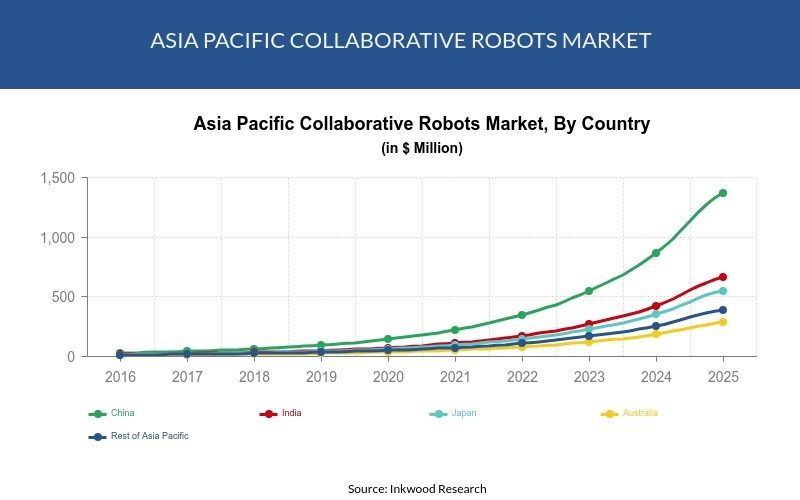
SME spending spree ahead
Rising Cobot Tsunami: Who Will Lead?
Cobot sales forecast to double by 2020, surging to 700k by 2025
Pain point: Which cobot manufacturers have capacity to meet the anticipated demand? None!
The perfect storm
There are over six million factories worldwide, over two million of which reside in China; and seventy percent of those six million are small-to-medium enterprises (SMEs). The Boston Consulting Group reports these global factories have automated only 10 percent of those functions capable of being automated.
Prior to the advent of the collaborative robot or cobot in 2008, automating production lines for most SMEs (that’s 7 of every 10 factories) was a near financial impossibility. “In an integrated turnkey system, often the robot is maybe one-third of the cost of the total installation,” says Ron Potter, Director of Robotics Technology for Factory Automation Systems. Sadly, the much-heralded robot revolution was hopelessly unavailable to most global factories; a situation that inhibited their productivity and competitiveness.
Certainly not the best of ways to roll out a revolution in automation.
See also: Special 2-Part Series: The Promise of Cobots…Delivered!
Quietly, the low-cost cobot arrives in 2008, and the revolution has a chance to spread out more evenly.
Slowly, the dawning of the cobot’s potential takes shape. The addressable market for cobots goes from zero to staggering because the factory automation challenge now has a viable solution.
It’s what prompts Bloomberg articles like Cheap Robots Are Helping Small Businesses Survive.
The case for cobots is overwhelmingly clear, and there are now 42 vendors with a cobot for sale.
A solid-performing, single-arm cobot can be had for under $20k—installed! Return on investment (ROI) is counted in months. Cobots are easy to set up, use and maintain. Re-orders as well as multiple orders from satisfied customers are growing more frequent. In fact, it’s hard to find dissatisfied customers. And cobots can be purchased online through Alibaba and delivered in a day.
The cobot has indeed arrived, and it has run headlong into the perfect storm.
The net-net of automation for any SME is a no-brainer: Get a cobot. A fact not lost on SMEs who are taking to cobots in unprecedented numbers to automate their production lines
The reasons for cobot popularity among SMEs are easy to understand. According to the Danish Technological Institute (DTI), there are five: Price, safety, flexibility, ease of use, and increased productivity. And, of course, the all-important return on investment (ROI).
The near-term sales figures for cobots (between 2019 and 2020) are eye-openers; the numbers beyond for 2020 through 2025 are nothing short of mind-boggling.
Here’s how HMC Investment Securities sees the rising tsunami of cobots taking place:

That automation allure is not lost on China’s SMEs looking for an edge in productivity, speed, and lowering overhead through labor reductions. However, in 2017, China purchased fewer than 3,000 cobots; a situation about to dramatically change: China in 2021 is forecast to order in some 80k cobots.
In cobotics’ biggest Asian neighborhoods, this is what the tsunami looks like from 2019 to 2025.; Mightily impressive!

With such cobot fortunes swirling through the industry, the world is quickly catering to all things cobotics. AUTOMATICA 2018 is a case in point. In Munich this year (June), it looked as though cobotics was getting ready swallow up classical industrial robotics; this video hints at the dramatic things awaiting AUTOMATICA 2020:
The real question arising from this quick look at anticipated demand for cobots comes to rest on which cobot makers have the capacity to meet that coming cobot demand? Right now, none!
No one is making a move on this massive cobot opportunity.
Even category leader, Universal Robots and its laudable 20,000 cobot installed base, is a mere salty splash when compared to the mega-demand riding in on the cobot tsunami.
Cobot leadership is wide open for a newcomer to storm the gates. The cobot numbers are just too large not to generate serious consideration. Think, Toyota Robotics, for example. Imagine Toyota cobots showcasing themselves in every Toyota automobile dealership worldwide.
All Toyota would need to get such an audaciously exciting plan off the ground is to first get a cobot. There are 42 cobot vendors out there to acquire.
